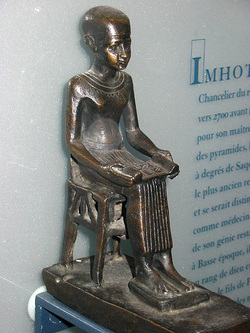
- Carlo Ginzburg
Early records on medicine have been discovered from ancient Egyptian medicine (some of the oldest documented); Babylonian medicine; Ayurvedic medicine, a Hindu system of traditional medicine native to the Indian continent, a southerly region of Asia, mostly situated on the Indian Plate and project southward into the Indian Ocean, and a form of alternative medicine; classical Chinese medicine, a broad range of medicine practices sharing common theoretical concepts which have been developed in China and are based on a tradition of more than 2,000 years, including various forms of herbal medicine, acupuncture massage (Tui na), exercise (qigong), and dietary therapy, predecessor to the modern traditional Chinese medicine (“TCM”); and ancient Greek medicine, which revolves around the theory of humours, and the medicine in ancient Rome, combining various techniques using different tools and rituals.
The Egyptian Imhotep, a polymath who served under the Third Dynasty king Djoser as chancellor top the pharaoh and high priest of the sun god Ra at Heliopolis (3rd millenium BC), is the first physician in history known by name. Earliest records of dedicated hospitals come from Mihintale in Sri Lanka, an island country in the northern Indian Ocean off the southern coast of the Indian subcontinent in South Asia, where evidence of dedicated medicinal treatment facilities for patients are found. The Indian surgeon Sushruta, an ancient Indian sage, who was one of the principal contributors to the ancient art and science of Ayurveda, described numerous surgical operations, including the earliest forms of plastic surgery, a medical specialty concerned with the correction or restoration of form and function.
See: Backhauling Product
 RSS Feed
RSS Feed